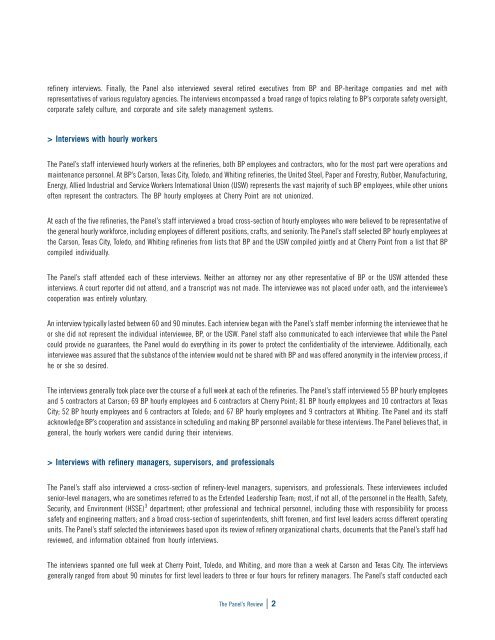The Baker Panel Report - ABSA
The Baker Panel Report - ABSA
The Baker Panel Report - ABSA
You also want an ePaper? Increase the reach of your titles
YUMPU automatically turns print PDFs into web optimized ePapers that Google loves.
efinery interviews. Finally, the <strong>Panel</strong> also interviewed several retired executives from BP and BP-heritage companies and met withrepresentatives of various regulatory agencies. <strong>The</strong> interviews encompassed a broad range of topics relating to BP’s corporate safety oversight,corporate safety culture, and corporate and site safety management systems.> Interviews with hourly workers<strong>The</strong> <strong>Panel</strong>’s staff interviewed hourly workers at the refineries, both BP employees and contractors, who for the most part were operations andmaintenance personnel. At BP’s Carson, Texas City, Toledo, and Whiting refineries, the United Steel, Paper and Forestry, Rubber, Manufacturing,Energy, Allied Industrial and Service Workers International Union (USW) represents the vast majority of such BP employees, while other unionsoften represent the contractors. <strong>The</strong> BP hourly employees at Cherry Point are not unionized.At each of the five refineries, the <strong>Panel</strong>’s staff interviewed a broad cross-section of hourly employees who were believed to be representative ofthe general hourly workforce, including employees of different positions, crafts, and seniority. <strong>The</strong> <strong>Panel</strong>’s staff selected BP hourly employees atthe Carson, Texas City, Toledo, and Whiting refineries from lists that BP and the USW compiled jointly and at Cherry Point from a list that BPcompiled individually.<strong>The</strong> <strong>Panel</strong>’s staff attended each of these interviews. Neither an attorney nor any other representative of BP or the USW attended theseinterviews. A court reporter did not attend, and a transcript was not made. <strong>The</strong> interviewee was not placed under oath, and the interviewee’scooperation was entirely voluntary.An interview typically lasted between 60 and 90 minutes. Each interview began with the <strong>Panel</strong>’s staff member informing the interviewee that heor she did not represent the individual interviewee, BP, or the USW. <strong>Panel</strong> staff also communicated to each interviewee that while the <strong>Panel</strong>could provide no guarantees, the <strong>Panel</strong> would do everything in its power to protect the confidentiality of the interviewee. Additionally, eachinterviewee was assured that the substance of the interview would not be shared with BP and was offered anonymity in the interview process, ifhe or she so desired.<strong>The</strong> interviews generally took place over the course of a full week at each of the refineries. <strong>The</strong> <strong>Panel</strong>’s staff interviewed 55 BP hourly employeesand 5 contractors at Carson; 69 BP hourly employees and 6 contractors at Cherry Point; 81 BP hourly employees and 10 contractors at TexasCity; 52 BP hourly employees and 6 contractors at Toledo; and 67 BP hourly employees and 9 contractors at Whiting. <strong>The</strong> <strong>Panel</strong> and its staffacknowledge BP’s cooperation and assistance in scheduling and making BP personnel available for these interviews. <strong>The</strong> <strong>Panel</strong> believes that, ingeneral, the hourly workers were candid during their interviews.> Interviews with refinery managers, supervisors, and professionals<strong>The</strong> <strong>Panel</strong>’s staff also interviewed a cross-section of refinery-level managers, supervisors, and professionals. <strong>The</strong>se interviewees includedsenior-level managers, who are sometimes referred to as the Extended Leadership Team; most, if not all, of the personnel in the Health, Safety,Security, and Environment (HSSE) 3 department; other professional and technical personnel, including those with responsibility for processsafety and engineering matters; and a broad cross-section of superintendents, shift foremen, and first level leaders across different operatingunits. <strong>The</strong> <strong>Panel</strong>’s staff selected the interviewees based upon its review of refinery organizational charts, documents that the <strong>Panel</strong>’s staff hadreviewed, and information obtained from hourly interviews.<strong>The</strong> interviews spanned one full week at Cherry Point, Toledo, and Whiting, and more than a week at Carson and Texas City. <strong>The</strong> interviewsgenerally ranged from about 90 minutes for first level leaders to three or four hours for refinery managers. <strong>The</strong> <strong>Panel</strong>’s staff conducted each<strong>The</strong> <strong>Panel</strong>’s Review C 2

















